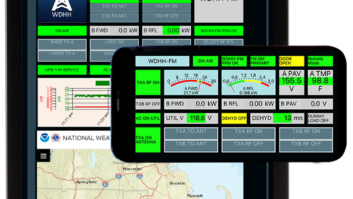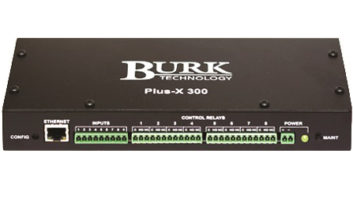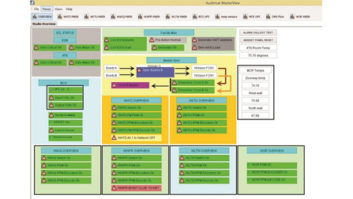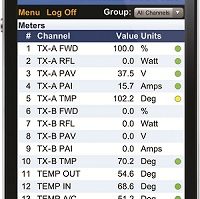Field Report: Burk ARC Plus
Jun 1, 2009 12:00 PM, By Michael Kernen

It was not all that long ago I relied on a Harris facility control system that used dry pairs to communicate between studio and transmitter sites, their modems using FSK at something like 110 baud. Moseley and a few others made systems like this enabling broadcasters to move the point of control from the transmitter to the studio effectively eliminating the full-time transmitter engineers’ job.
Performance at a glanceIP-based remote control
Vacuum Fluorescent Display
E-mail alerts and notifications
Expandable system design
256 metering channels and status channels
256 relay pairs
512 virtual channels
Those systems had the same three basics we use today: Telemetry in the form of status indicators and metering combined with control via contact closures. Burk has made its own inroads in the broadcast facility control marketplace. Fact is, it has become the foremost purveyor of such technology, even winning Pick Hit awards for its ARC Plus family components the ARC Plus, Plus-X 300 and Plus-X AC-8.
What makes a better facility control system? Flexible connectivity, rock-solid reliability, expandability and the ability to automate corrective action � all flavors of the aforementioned are included in Burk’s ARC Plus.
System overview
ARC Plus is available with or without the Enhanced Speech Interface. Status and metering inputs are added by the 1RU Integrated Input Unit (IIU), which supports 16 of each. Up to 256 channels of status and metering are available. Command channels are added eight at a time by installing Integrated Command Relay Units (ICRU) (eight raise/eight lower). Both units connect via Burk’s Plus Bus network, which is essentially RS-422. A single system can scale to more than 1,000 sites.
There are several compelling options and accessories for the Plus. The Plus-X 300 I/O Interface allows system connection of eight status or metering (in any combination), and eight command channels to be placed anywhere there is network access. The ARC Plus SL is essentially a lower cost ARC Plus without the front panel controls that works exclusively with Plus-X devices. Plus Connect is a direct interface between the Plus system and several popular transmitter models. Plus-X AC-8 is an eight-outlet power strip that can be controlled via its built-in Web interface or fully integrated into an ARC Plus system. A variety of accessories are available from arc and flame detectors, several temp sensors, voltage and current sensors, even a tower light monitor.
Connectivity

The big screen display in the engineering offices
The ARC Plus features an excellent Java-based Web interface, mobile Web access via Blackberry, Iphone, etc. and the company’s much-improved Auto Pilot Plus software. Simple interaction is accomplished with Burk’s Enhanced Speech Interface and any touchtone phone. ARC Plus communicates with its brothers via IP over closed or public networks. Control points can be located literally anywhere there is Internet access and each unit can see any other unit. A straight modem-to-modem connection is supported for those lacking Internet access at the tower.
The ARC Plus is extremely easy to get started. We decided to connect our existing ARC16 equipment via the Plus’ rear panel RS-232 port and after a few minutes in Auto Load (included) we had full control of our site. To date we have expanded the system to include five sites each with their own unique combinations of I/O and accessories. After spending a little time with the Auto Pilot software, I created a custom view that we continuously display on a 37″ LCD monitor in the engineering office (see photo, next page). Custom views allow users to build a collection of meters, status indicators and controls, along with a variety of other elements such as Web content, SNMP content, even a Bird Power Meter. With it we can keep a close eye on things without having to log in. We monitor a wide range of systems’ statuses here. Our UPS system, all of our critical PPM encoding, silence detectors, room temperatures, and we have room for plenty more as needs arise.
I’ve grown to appreciate the Plus’ ability to allow alarm reporting in different ways. Depending on preference, each alarm can be independently programmed to alert the user in several ways: e-mail, SMS text messaging, telephone or simply on screen. You can even have it alert different people depending on the particular alarm. Logging and event lists are supported as well.
Burk TechnologyP
W
E 800-255-8090
www.burk.com
[email protected]
Another favorite are the macros. Burk’s ARC Plus system allows the user to create macros that will monitor conditions and take corrective action. For instance, if a transmitter’s power creeps too high, an ARC Plus macro can respond by lowering the transmitter power. If several actions need to occur in a particular order, the user can create a macro that carries out the sequence of commands. I’ve created several macros: one that continually runs shows whether a site is on the air, another allows me to mute all alarms at a site with one click during maintenance. I will eventually write one to automate site switching � it will bring the Aux site online and shut down the main while checking each element during the sequence. Macros can be scheduled too, useful for automating daily pattern switching.
Burk is a wonderful company to work with. I have gotten to know several people behind the scenes over the years and have had the good fortune to demo beta software and participate some in their product development. The Plus is the logical next step for anyone looking to interconnect sites, or simply make the leap to IP-based control. Burk remains very focused on their broadcast clientele, so it’s a good bet that their products will continue to exceed our expectations. Besides, have you tried to order any dry pairs lately?
Kernen is chief engineer of Greater Media Detroit.
Editor’s note: Field Reports are an exclusive Radio magazine feature for radio broadcasters. Each report is prepared by well-qualified staff at a radio station, production facility or consulting company.
These reports are performed by the industry, for the industry. Manufacturer support is limited to providing loan equipment and to aiding the author if requested.
It is the responsibility of Radio magazine to publish the results of any device tested, positive or negative. No report should be considered an endorsement or disapproval by Radio magazine.









